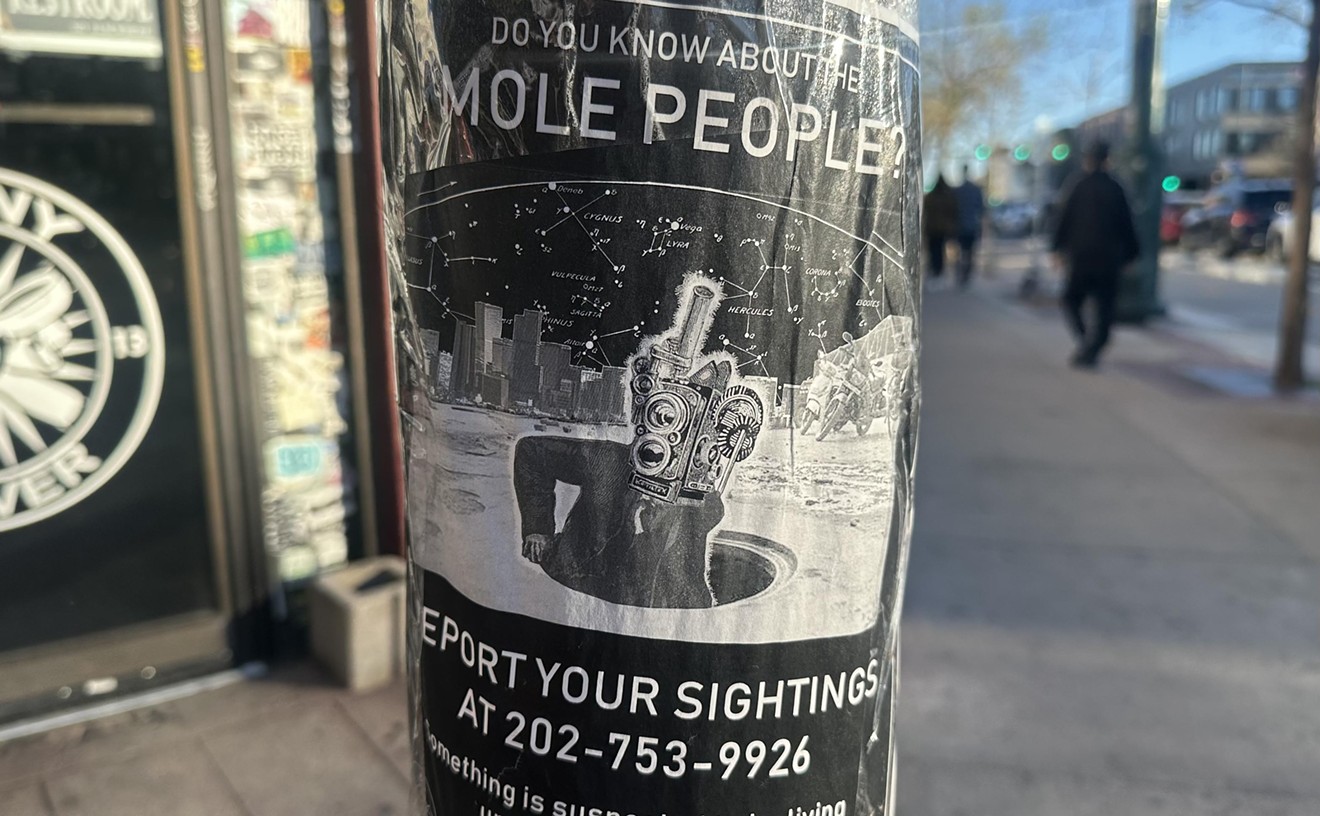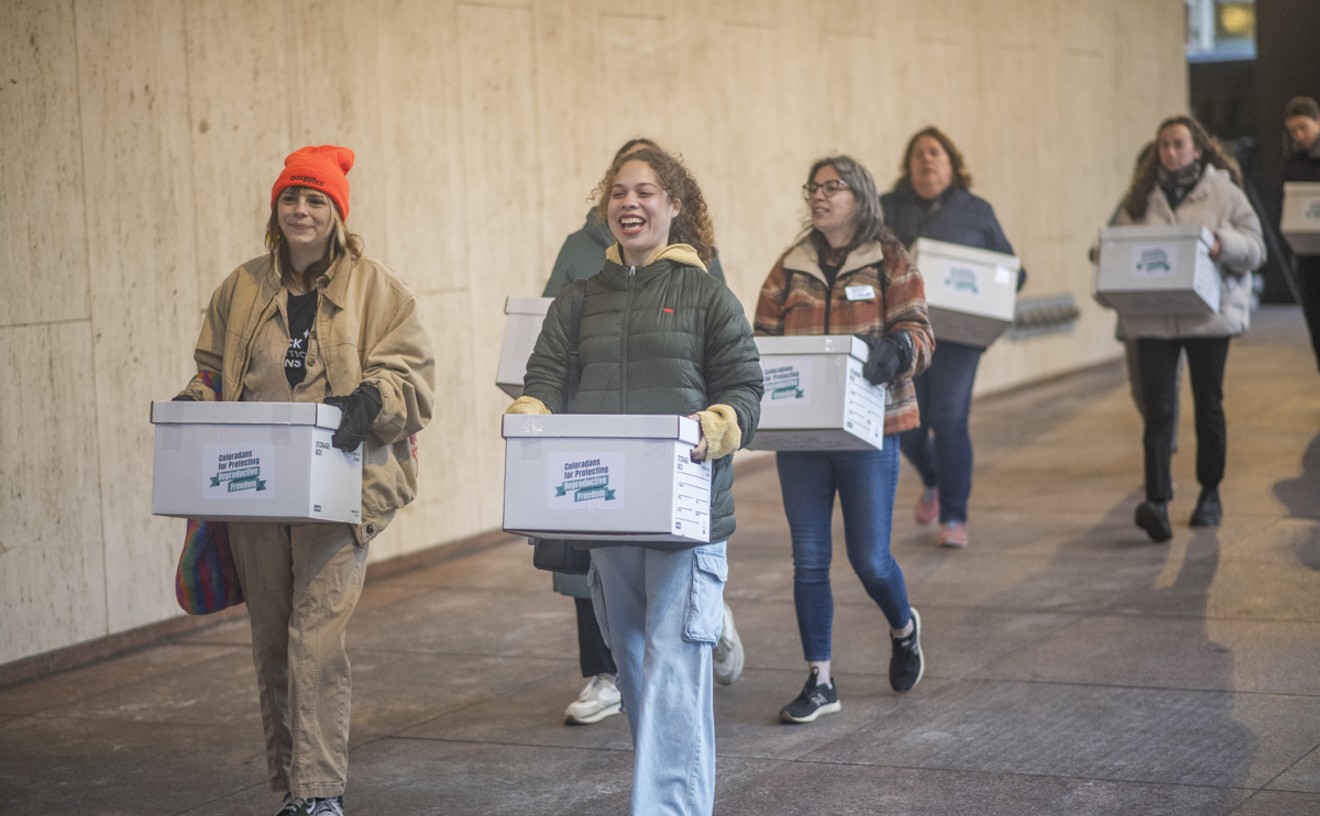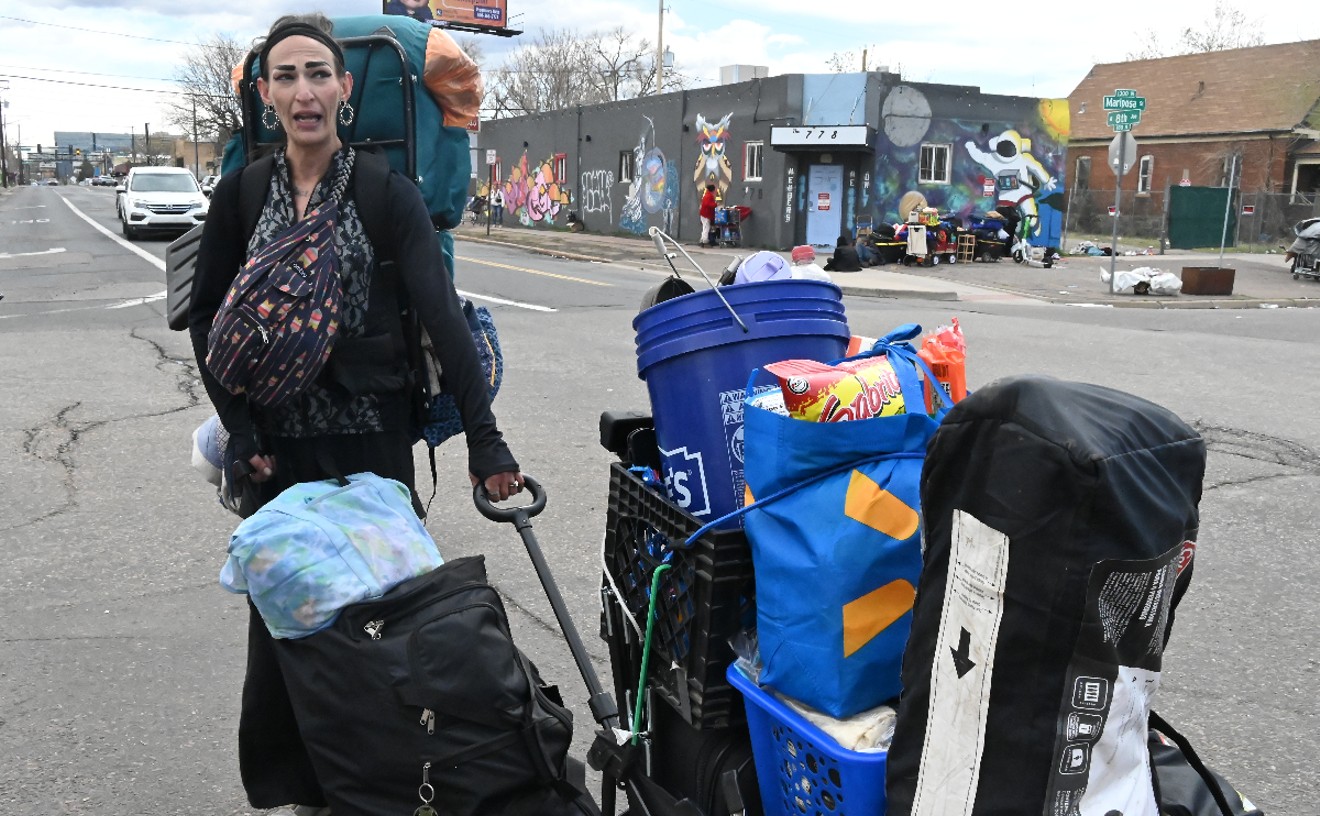Raw testosterone leaks from slits on either side of their broad faces, running in rivulets down the wrinkled folds of their gray skin like liquid sideburns. The smell is acrid; one elephant researcher even described it as "evil." It's a stench that, when mixed with the potent urine constantly dribbling down the backs of their thick legs, can turn stomachs from several hundred feet away.
The foul-smelling secretions are a harbinger of a very special time in a male elephant's life, a time worthy of its own young-adult novel, something with a title like Are You There, God? It's Me, Ranchipur. Known as musth, this period can last anywhere from a few days to several months and is characterized by elevated hormone levels, heightened sexual interest and aggressive activity.
Basically, it's like middle school — with 12,000-pound students.
"They're pretty much interested in two things," says Dale Leeds, the curator of large mammals at the Denver Zoo, who's worked with elephants for more than twenty years. "They both begin with F. One is fighting."
In the wild, bulls roam alone for hours on end, searching for herds of females — some of whom they hope will be up for getting down — and fending off other males who might be their competition. Their penises protrude all the time and, perhaps because of the continuous urination, grow algae — a condition known as "green weenie."
And Denver is poised to become the green weenie capital of North America.
The Denver Zoo will break ground, hopefully, this year on a new, partially publicly funded exhibit called Asian Tropics. The centerpiece will be a habitat capable of housing twelve elephants, which would make it one of the largest in the country. Up to eight of those elephants could be male, and housing them together as a bachelor herd would be a feat never before accomplished in the U.S. But it could be necessary.
Asian elephants are endangered. To help protect the species, zoos figure they should beef up their captive breeding programs. About 83 percent of the total number of Asian elephants in North America are females, but since half of the newborns will be boys — who will grow to be ten feet tall and weigh as much as two Hummers — the zoos will need bigger, stronger exhibits in which to house them.
"Somebody's got to wrestle with the issue of how you manage a group of bull elephants," says Denver Zoo President and CEO Craig Piper. "That's something we could step up to more quickly than establishing a breeding program. We could make a home for a bunch of these younger bulls and work with their social dynamics and how to manage them, and those other zoos could get back into breeding, which is critical."
But effectively starting an elephant frat house is easier said than done. Less is known about male elephants than female elephants — and the mysteries surrounding musth are many. What triggers it? Why does the duration and intensity vary from bull to bull? Do bulls affect each other's musths? What would happen if two musth males were put together? Would they fight to the death?
"You really don't know how those dynamics are going to work," Piper says. "A little bit is, it's getting your own nerve up to do it."
In other words, it takes balls. Big ones.
It's estimated that there are between 30,000 and 50,000 Asian elephants left in the wild, in countries such as Thailand, Sri Lanka and India. By comparison, it's estimated that there are up to 690,000 wild African elephants. North America is home to just under 300 Asian elephants, about half of which live in zoos. The other half belong to circuses or are in private hands. Of those that live in zoos, only 25 are male.
In early 2005, the directors of 78 North American zoos that keep Asian elephants met to review a fresh draft of a long-term plan for the species' survival. One of the plan's key goals was to increase capacity, especially for males. Most zoos don't have any, partly because females are smaller, less aggressive and easier to house. Zoos that do have males have only one or two, as that's all that's needed for breeding.
But the plan suggests that zoos interested in breeding elephants should strive to hold up to twelve animals, including two males, and that non-breeding zoos should hold up to six elephants, with the capability to house all bulls.
"There was an overwhelming feeling that zoos needed to elevate their game," says Steve Feldman, spokesman for the national Association of Zoos and Aquariums, which hosted the meeting on behalf of its Elephant Taxon Advisory Group, made up of experts who drafted the plan. "If you're going to have a self-sustaining, diverse population, you need to give the elephants the opportunity to breed, and you need room for babies."
The Denver Zoo had already been planning to rebuild its elephant exhibit as part of its twenty-year master plan, and the meeting heavily influenced the organization. While other zoos weren't ready "to make that step" toward housing bulls, Piper says, "our team was."
"Ultimately, male elephants take an entirely different construction technology and exhibitory technology to keep in the long term, when they start to mature and get larger and come into sexual maturity and hormonal maturity," says George Pond, the zoo's vice president for planning and capital projects. "There's not a lot of homes for them."
And not enough homes could cause the entire North American baby-elephant machine to grind to a halt. "There are...colleagues of ours who have had to make the decision to stop breeding, which is pretty significant," Pond says. "We discovered that we can bring something — not only to Denver, but to the entire industry — that is needed."
Building a facility capable of housing some of the world's biggest animals isn't cheap. With an estimated cost of $50 million, Asian Tropics will be the zoo's most expensive master-plan project to date.
Half of the money will come from a $62.5 million zoo-improvement bond issue approved by Denver voters in 1999. The first $36 million of that bond has already been spent on projects such as a 764-space parking garage, a komodo dragon exhibit and Predator Ridge, an exhibit that houses lions, hyenas and wild dogs in rotating habitats, a model zoo officials plan to replicate in Asian Tropics.
The other half of the $50 million is supposed to come from private donations, but the zoo has had trouble raising the money because of the faltering economy. As of April, it was still $10 million short, says zoo spokeswoman Tiffany Barnhart.
With the bond set to expire in November, the zoo asked the Denver City Council in May to amend the agreement that required the zoo to raise $25 million in order to receive the bond money. Instead, the zoo asked to be given the $25 million in bond money now, with a promise that it would raise the matching funds by 2013. The council agreed.
"It's just this last bit of money they need to match, and if they don't, they lose it," says Councilwoman Carla Madison, whose district includes the zoo. "I think the zoo has fundraising capacity enough to match the money."
Zoo officials think so, too. "We know it will help our fundraising efforts to not only be able to share drawings with people, but to bring them out onto the site and let them see the work that's going on," Piper says.
Beyond building costs, it costs about $73,000 a year just to feed and care for each elephant, Barnhart says. That estimate includes the cost of food and staff but not the cost of veterinary services, which varies depending on an animal's health. The money to care for the elephants will come out of the zoo's operating budget, which was $22.8 million last year. The zoo is funded by a mix of public and private money.
The Denver Zoo began with one bear. It came to the Mile High City in 1896 via the Wells-Fargo Express Company, addressed to one Mr. Bailey. It was apparently sent by a buddy of his who believed that Bailey, an avid hunter, would enjoy adding a live black bear to his collection. Alas, he did not, as the sub-headline of a story from the November 6, 1896, edition of the Denver Evening Post reveals: "It Arrived at the Wells-Fargo Office Yesterday and Created Bedlam — Then It Was Taken to Mr. Bailey's House, and Mrs. Bailey Fled for Her Life — It Is Now Perched on a Back Fence."
The bear, called Billy Bryan, was donated to the city and housed in a spot in City Park. Thus, the Denver Zoo was born.
For the next 50 years, the zoo grew somewhat haphazardly, according to The Denver Zoo: A Centennial History, written for the zoo's 100th birthday, in 1996. Native species like buffalo and mountain lions and non-native species such as monkeys were added piecemeal to the collection. Visitors could drive or bicycle right up to their cages.
But by 1946, the zoo had fallen into disrepair. One popular Rocky Mountain News columnist called it "third rate" and urged city leaders to do something about it. Over the next few years, they did. In 1950, the Denver Zoological Foundation was formed. That same year, the zoo got its first elephant: a female named Cookie.
"The acquisition of Cookie was the first significant effort to involve the entire Denver community in the zoo's future, to get Denver citizens to make a direct financial contribution and an emotional commitment to the zoo," wrote Carolyn and Don Etter in The Denver Zoo. Indeed, Cookie debuted to record crowds. In 1959, the zoo added a second elephant named Candy and built the pair a new exhibit, dubbed the Pachyderm Habitat. Though remodeled, it's the same exhibit that stands today and is home to the zoo's two older, post-reproductive female elephants, Mimi and Dolly.
To Piper's knowledge, Cookie, Candy, Mimi and Dolly are the only elephants who have ever lived at the Denver Zoo long-term.
But unlike the impact of Cookie's arrival in Denver, Piper isn't banking on Asian Tropics to hugely increase zoo revenues or membership. "I would love to think we'll have more people come visit the zoo, but that's not the driving force behind it," he says. "The driving force is to help elephants. And certainly, the more people who come visit does help that cause, [because] it allows us to put more dollars in the coffers of our field conservation programs."
The zoo has several such programs, including some that help native Asians co-exist with the elephants that sometimes raid their crops.
Still, Pond adds that Denverites should be proud to have such a rare and groundbreaking exhibit in their city: "Our 1.9 million guests are going to get the best elephant exhibit in the world as the result of this master plan."
Asian Tropics will be built within the zoo's existing footprint, on a boomerang-shaped piece of land on the zoo's southern edge — sandwiched between Bird World and the existing yak exhibit. The site stretches over ten of the zoo's eighty acres.
Today the area houses hoofed animals, such as white-lipped deer and oxen, as well as mountain lions and Pallas's cats, a type of wild Asian feline that looks like a stocky housecat. Most of the animals currently on the site will be moved to other locations in the zoo once the exhibit opens, Piper says.
However, a few species, such as the bison that now occupy a space in the eastern part of the ten acres, will leave permanently. They could be relocated to another zoo or used to start a new wild herd in Colorado. The zoo will also lose its ankole cattle, African cattle that resemble Texas longhorns. According to Piper, they were loaned to the zoo with the expectation that they would be returned once the new exhibit is built.
Asian Tropics will be home to three main species: the elephants, Malayan tapirs and Indian rhinos. The rhinos are even more endangered than the elephants; there are fewer than 3,000 left in the wild. But crowd-pleasing elephants will be the centerpiece.
The zoo will build an 18,000-square-foot elephant barn in the middle of the exhibit, complete with eight elephant stalls. There will be a big communal space in the center, dubbed "the parlor." Visitors will be able to see into the parlor, which could be occupied at any time by any combination of compatible elephants, just hanging out.
The barn will be built stronger and the stalls tougher to accommodate the taller, heavier male elephants, zoo officials say. The staff won't have direct physical contact with the bulls — a management technique proven to work with male elephants, in addition to other safety measures. "The facility is designed very carefully to keep the animals where they belong and the staff where they belong," Piper says.
He points out that animals who do stray from their area will often realize they are in unfamiliar surroundings and head back to their habitat on their own. And there's an emergency plan in place — as there are with all of the animals — in case an elephant stampedes.
Asian Tropics will have five outdoor habitats. The three main species will rotate between them, while the exhibit's smaller animals — including fishing cats, leopards and otters — will stay put. On any given day, Mimi and Dolly could be in one habitat while a group of rowdy teenage boy elephants could be in another, within sniffing distance of some rhinos but separated by metal cables, a deep moat or a tall building.
Moving the animals from habitat to habitat ensures they won't get bored, Pond says, and allows visitors to be surprised. "It's not the rhino yard or the elephant yard," he says. "It's the I-don't-know-what-you're-going-to-get-today, surprise-me yard."
But even with plans for an intricate animal transfer system — including numerous walkways and gates, a public railroad-crossing-type path and an elevated elephant bridge — it can be tricky to make a male elephant budge, especially a male elephant in musth.
A bull in musth is like that drunk guy at the bar, says elephant behavioral researcher Bruce Schulte of Georgia Southern University. He might not be the sharpest guy in the room or the biggest or the strongest, but after a half-dozen beers, nobody wants to find out. "He's sending signals to the males like, 'Hey, you might want to leave me alone,'" Schulte says. At the same time, "he's sending signals to the females: 'Hey, I'm the right guy. I've got the Corvette. I've got the best aftershave. Come date me.'"
Boy and girl elephants are different almost from the get-go. While both are born into all-female herds, as youngsters, girls are more interested in playing house and helping to raise the babies, says Margaret Whittaker, who's worked with elephants for eighteen years and is currently an animal behavior consultant in Texas. Boys, on the other hand, are interested in playing rough. They push and shove one another, playacting the sparring techniques that will help them establish dominance as adults.
Whereas females will live in the herd for the rest of their lives, males leave once they reach eight, nine or ten years old. Or rather, their mothers kick them out because they keep trying to mount their aunties and cousins, says Ted Trujillo, the elephant manager at the Rio Grande Zoo in Albuquerque, New Mexico, which is home to a pair of bulls ages ten and eleven, one of whom has already been banished by the females. "Then they'll pair up with other bulls and learn the process of being a bull," he says.
It's in these wild bachelor herds that teenage bulls first go through something known as "moda musth." It's like musth lite; they secrete fluid from their glands but the smell is sweet, sort of like honey. It lasts only for a day or two, and older bulls — those in real musth — don't see the teenage bulls as a threat, because they know the ladies aren't interested. "They're kind of like humans," Schulte says of female elephants. "College girls aren't as likely to date eighth-grade boys."
Real musth starts when males are in their twenties. But scientists don't know why it occurs. It's not needed for breeding, as males can impregnate females at any time. And there doesn't seem to be any rhyme or reason behind its unpredictable timing. Different bulls go into musth at different times of the year for different lengths of time. But scientists do know this: When a bull is in musth, he breaks off from the bachelor group and goes off by himself to look for females. When he's successfully mated or when his musth wears off — another unexplained phenomenon — he'll typically rejoin the group, though bulls tend to become more and more solitary as they get older.
Even if a bull manages to do the deed, there's no guarantee he'll become a father. It's not easy to get female elephants pregnant. One reason is that they have a fourteen- to sixteen-week menstrual cycle, meaning they can only conceive once every four months. Another is that pregnancy lasts 22 months, and when a mother gives birth to her 250-pound baby, she nurses it for two to four years. Only then is she ready for another go.
Age is also a barrier. Researchers recently discovered that a female's chances of getting pregnant drop off significantly if she hasn't had her first baby by the time she's in her early twenties. On average, elephants live to be about sixty years old.
Males, on the other hand, seem to become more virile over time. One theory is that musth is tied to an animal's weight — it takes a lot of energy to get that worked up — and since Asian elephants continue to grow until they die, the biggest males have the biggest, baddest musths. Though there's some debate about whether females prefer males in musth, there's no question that a musth male temporarily rises to the top of the boys'-club hierarchy, increasing his chances that the other bulls will step back and let him have first crack at the cows.
And pity the fool that gets in his way.
Researchers think the Hansel-and-Gretel-like trail of urine left behind by a musth male wherever he goes acts as a signal to other non-musth males to steer clear. It's only when a musth male comes across another musth male — especially one the same size and strength as him — that there could be trouble.
"When two musth males interact — and interact aggressively — in the wild, they're fighting to the death," says Joyce Poole, who has studied wild elephants in Africa and Asia for more than thirty years and is now the director of research and conservation for the nonprofit ElephantVoices. She's seen fights last for eight hours at a time, with the males clashing and backing off, clashing and backing off. Sometimes an elephant will mortally wound another with his tusks. Other times, one will forfeit and run away.
"If they don't have the space to do that, one elephant could pin another against a fence or something and kill him," Poole says.
And experts agree that in a group of eight male elephants, the chances that more than one will be in musth at any given time are pretty good. "In a zoo setting, if you had multiple males in musth, it's not going to be a fun day at work," says Daryl Hoffman, curator of large animals at the Houston Zoo and the executive director of the Elephant Managers Association.
Bulls in musth are kept separately at the few U.S. zoos that have more than one. Which, for those elephants, is no different than usual.
The behemoth Ringling Bros. and Barnum & Bailey Center for Elephant Conservation in central Florida owns nine bulls, one of the largest collections in the U.S. Five of them are considered "breeding bulls," says Dennis Schmitt, the center's chair of veterinary services and director of research. Though they can see each other through fences and communicate by sound and smell, they don't have any physical contact.
It's the same at the Oregon Zoo in Portland, where 47-year-old Packy, 38-year-old Tusko and 26-year-old Rama are all sometimes in musth at the same time, says zoo deputy director Mike Keele. "We keep them apart because we're afraid they'll fight," he says. "It's okay to tussle and establish dominance, but we'd be hard-pressed to stop bulls who weigh 12,000 pounds and 10,000 pounds from injuring each other."
But there's a difference between what those facilities do and what Denver plans to do. The animals in Florida, Portland and a handful of other zoos weren't raised together. It's common for elephants to move from zoo to zoo throughout their lifetimes, and many don't end up in a facility with another male until they're adults, already set in their ways. The Denver Zoo is hoping that by acquiring juvenile bulls, they'll be able to socialize them young so that they're used to one another. Then, by the time they're fully grown, they will have worked out a social hierarchy that will prevent dangerous fighting.
But large-animal curator Leeds still doesn't know if the zoo will house musth males together. "That's one of the reasons I'm so interested in doing this project that's going to concentrate on males. You're asking questions now that people don't know the answers to because they haven't had the opportunity to observe it."
Leeds has an elephant-sized soft spot for the giant animals. Although he's not a scientist, he can expound on the science of breeding, on subjects like male gametes and the luteinizing hormones that trigger ovulation in females. He's also passionate about the importance of coupling captive breeding with efforts to protect elephants in the wild.
He even has a tattoo on his left calf of a black-and-white African bull with huge tusks. "I understand them," he says. "They understand me. We get along well. They have a lot of characteristics that are meaningful to me, like intelligence, loyalty, affection. Things that I admire in people that I admire in them as well."
He can tick off his favorite bulls like he's naming old college buddies. There's Packy, the tall, sweet bull, in Portland. And "tough boy" Rajah in Florida.
And he'll proceed with caution in Denver. "It would be inappropriate, in my opinion, to keep adult males that are both in musth [together], because at some point — again, using our kind of vague paradigm of following the natural history as close as possible — at some point, in the wild setting, somebody loses and goes away," he says. "You can't lose and go away here."
Keele, who in addition to working at the Oregon Zoo is the keeper of the AZA Asian Elephant Studbook, which tracks all of the Asian elephants in North America, echoes Leeds. "We don't have experience doing this. We're going to do it together," he says of Denver's plan. "What Denver could learn will be real valuable."
And there's certainly a lot to learn, both about bulls and breeding. Despite recent advancements, the captive breeding of Asian elephants is far from an exact science. Of the forty captive births that occurred between 1999 and February 2007, only 23 babies survived, the studbook says. Some were stillborn; others succumbed to disease. There is also some evidence that keeping captive males together suppresses their fertility.
The breeding plan for Denver's bulls is flexible. It could happen one of several ways: A bull could travel to a zoo where there is a breeding-age female; a female could travel to Asian Tropics; artificial insemination could be used; or a bull could mate naturally with a breeding-age female living in Asian Tropics, a less likely scenario, but not out of the question. Sending elephants cross country for breeding is pricey; the last time the Denver Zoo sent one, in 2001, it cost $10,200, Barnhart says.
Denver isn't the only zoo building more space for bouncing baby boys. Several other big zoos — including those in Los Angeles, San Diego and Washington, D.C. — are expanding their elephant exhibits, despite some outcry from animal-rights groups and other people who insist that no zoo is large enough to handle the world's biggest land mammals. Like Denver, those zoos are building both bull stalls and maternity stalls as well as setting aside space to do artificial insemination, just in case.
Asian Tropics is likely to cull its bulls from animals already in the U.S.; importing them from overseas is expensive and frowned upon. But zoo officials say it's too early to determine which bulls will come to Denver, since the exhibit won't be finished until 2011 or 2012.
In June, the zoo solicited bids from general contractors interested in building the exhibit. They received ten responses and hope to choose a contractor by September. "We'll start construction as soon as we have that contractor in place," Piper says. "We're ready to go."
When it's completed, the zoo's two current elephants, fifty-year-old Mimi and forty-year-old Dolly, will probably be the first to see it. "I want to walk Mimi and Dolly from their current facility to Asian Tropics and see the excitement of them exploring that new habitat, first and foremost," Piper says.
On a hot summer afternoon, it's easy to see that Mimi and Dolly are among the Denver Zoo's most popular attractions. Kids in matching summer-camp T-shirts crowd around the fence that surrounds their exhibit, leaning over to watch as the lumbering ladies give themselves dust baths and try to shake treats from a giant ball suspended from a chain like an enormous Kong dog toy. Fathers hold up babies, and old women in wheelchairs snap pictures.
At one point, Mimi turns her back to the visitors and starts to poop. Kindergarteners ooh and aah as softball-sized turds fall in a heap on the ground. Then she drenches the pile with a deluge of urine, like someone's turned on a huge faucet. "The elephant did pee-pee!" one small girl cries, pointing at the wet pile. "It looks like soda!" a boy shrieks.
Piper and Barnhart, the zoo's communications director, are standing nearby and don't bat an eye. To them, elephant poop is mundane, the stuff of everyday life. Instead, they prefer to envision what it will be like when there's an entire exhibit full of majestic bulls. "Asian Tropics is an exhibit like no other in terms of being able to see, potentially, a large group of bulls together," Piper says.
But not everything about that scenario could be described as "majestic." Visitors will be able to smell musth and maybe witness a boy-on-boy tussle. Or perhaps, if the zoo ever hosts a female of breeding age, catch a glimpse of some late-afternoon lovemaking. And they'll most definitely be treated to a gander at an elephant penis, up to four feet long, twelve inches wide and shaped like an S.
But then, the Denver Zoo has the balls to handle it.











